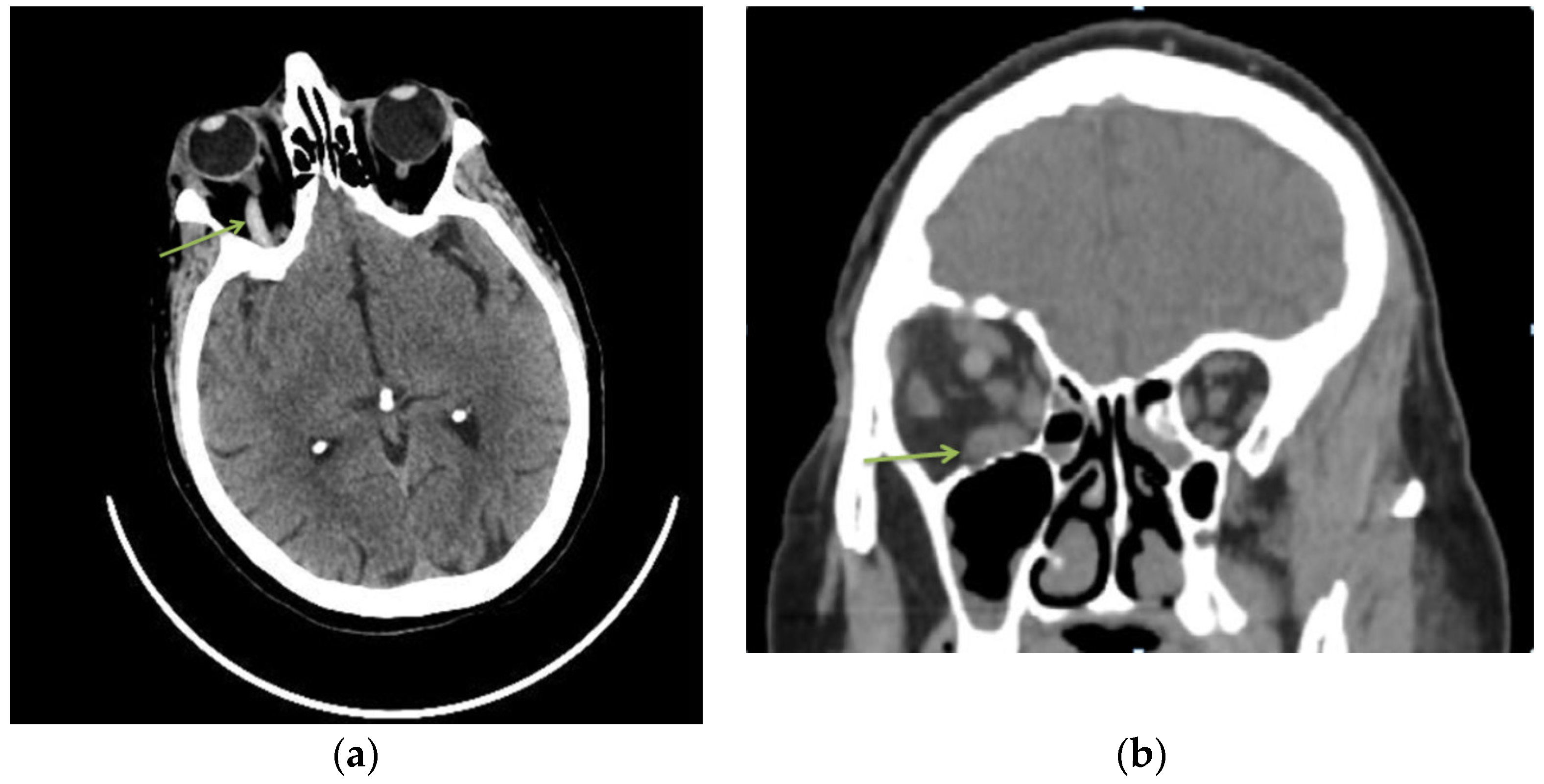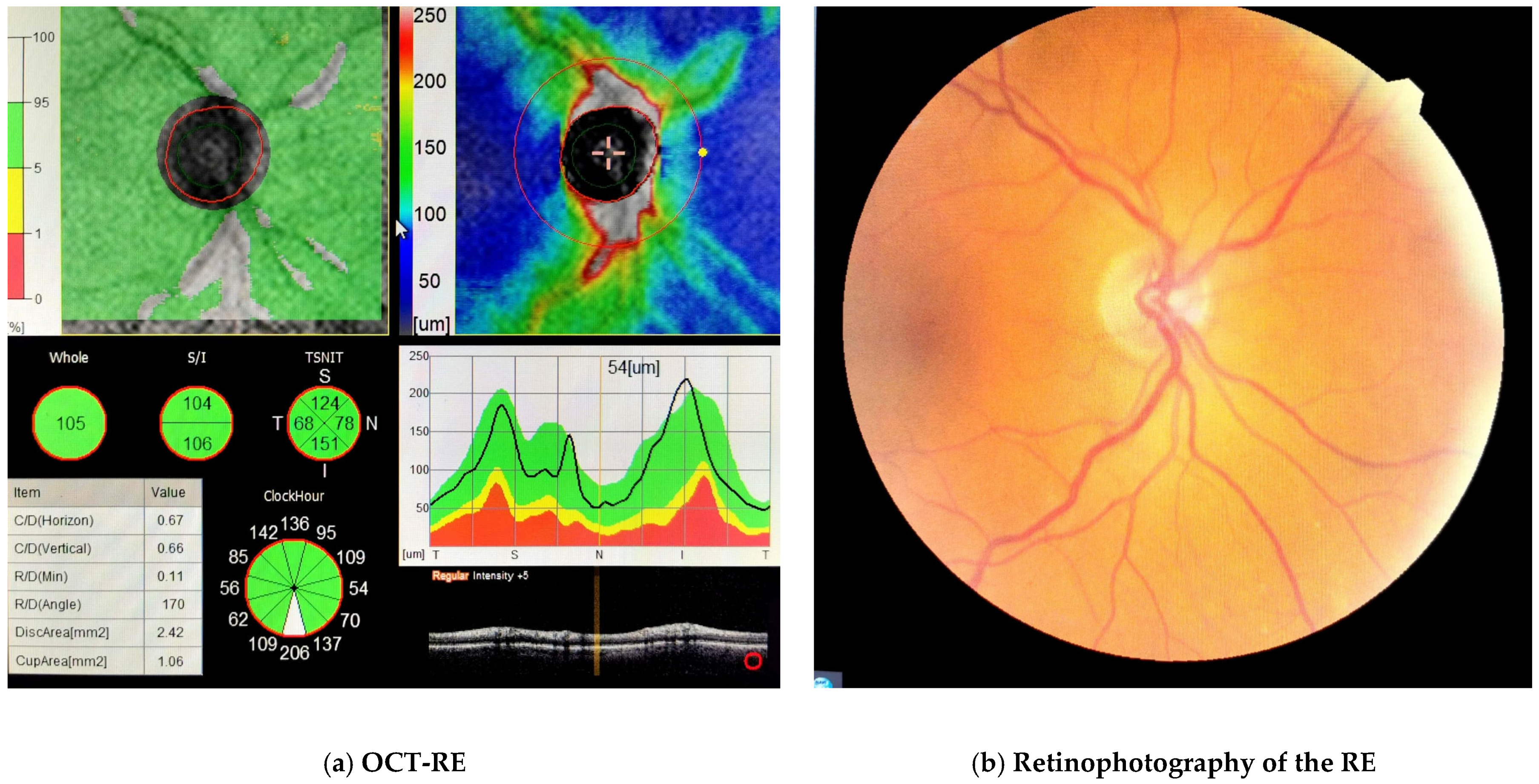Ophthalmic Vein Thrombosis Associated with Factor V Leiden and MTHFR Mutations
Abstract
:Author Contributions
Funding
Institutional Review Board Statement
Informed Consent Statement
Data Availability Statement
Conflicts of Interest
References
- Ozcan, Z.O.; Mete, A. Isolated Superior Ophthalmic Vein Thrombosis Associated with Orbital Cellulitis: Case Report. Beyoglu Eye J. 2020, 5, 142–145. [Google Scholar]
- Lim, L.H.; Scawn, R.L.; Whipple, K.M.; Oh, S.R.; Lucarelli, M.J.; Korn, B.S.; Kikkawa, D.O. Spontaneous superior ophthalmic vein thrombosis: A rare entity with potentially devastating consequences. Eye 2014, 28, 348–351. [Google Scholar] [CrossRef] [PubMed]
- Michaelides, M.; Aclimandos, W. Bilateral superior ophthalmic vein thrombosis in a young woman. Acta Ophthalmol. Scand. 2003, 81, 88–90. [Google Scholar] [CrossRef] [PubMed]
- Mandić, J.J.; Mandić, K.; Mrazovac, D. Superior Ophthalmic Vein Thrombosis with Complete Loss of Vision as a Complication of Autoimmune and Infective Conditions. Ocul. Immunol. Inflamm. 2018, 26, 1066–1068. [Google Scholar] [CrossRef]
- Cumurcu, T.; Demirel, S.; Keser, S.; Bulut, T.; Cavdar, M.; Doğan, M.; Saraç, K. Superior ophthalmic vein thrombosis developed after orbital cellulitis. Semin. Ophthalmol. 2013, 28, 58–60. [Google Scholar] [CrossRef] [PubMed]
- Rao, R.; Ali, Y.; Nagesh, C.P.; Nair, U. Unilateral isolated superior ophthalmic vein thrombosis. Indian J. Ophthalmol. 2018, 66, 155–157. [Google Scholar] [CrossRef]
- Bagot, C.N.; Arya, R. Virchow and his triad: A question of attribution. Br. J. Haematol. 2008, 143, 180–190. [Google Scholar] [CrossRef] [PubMed]
- Sotoudeh, H.; Shafaat, O.; Aboueldahab, N.; Vaphiades, M.; Sotoudeh, E.; Bernstock, J. Superior ophthalmic vein thrombosis: What radiologist and clinician must know? Eur. J. Radiol. Open 2019, 6, 258–264. [Google Scholar] [CrossRef] [PubMed] [Green Version]
- Sakamoto, M.; Kurimoto, T.; Mori, S.; Ueda, K.; Keshi, Y.; Yamada, Y.; Azumi, A.; Shimono, T.; Nakamura, M. Vasculitis with superior ophthalmic vein thrombosis compatible with neuro-neutrophilic disease. Am. J. Ophthalmol. Case Rep. 2018, 12, 39–44. [Google Scholar] [CrossRef] [PubMed]
- Park, J.; Armstrong, G.W.; Cestari, D.M. Spontaneous Superior Ophthalmic Vein Thrombosis in a Transgender Man with Systemic Lupus Erythematosus. LGBT Health 2019, 6, 202–204. [Google Scholar] [CrossRef]
- Sambhav, K.; Shakir, O.; Chalam, K.V. Bilateral isolated concurrent superior ophthalmic vein thrombosis in systemic lupus erythematosus. Int. Med. Case Rep. J. 2015, 8, 181–183. [Google Scholar] [CrossRef] [Green Version]
- Baidoun, F.; Issa, R.; Ali, R.; Al-Turk, B. Acute Unilateral Blindness from Superior Ophthalmic Vein Thrombosis: A Rare Presentation of Nephrotic Syndrome from Class IV Lupus Nephritis in the Absence of Antiphospholipid or Anticardiolipin Syndrome. Case Rep. Hematol. 2015, 2015, 413975. [Google Scholar] [CrossRef] [PubMed] [Green Version]
- Dey, M.; Charles Bates, A.; McMillan, P. Superior ophthalmic vein thrombosis as an initial manifestation of antiphospholipid syndrome. Orbit 2013, 32, 42–44. [Google Scholar] [CrossRef]
- Bansal, P. Factor V Leiden and MTHFR mutations as a combined risk factor for hypercoagulability in referred Patients population from Western India. Mol. Cytogenet. 2014, 7, 28. [Google Scholar] [CrossRef] [Green Version]
- Fegan, C.D. Central retinal vein occlusion and thrombophilia. Eye 2002, 16, 98–106. [Google Scholar] [CrossRef]
- Mahmoud, A.; Khairallah, M.; Amor, H.H.; Lahdhiri, M.H.; Abroug, N.; Messaoud, R.; Khairallah, M. Heterozygous factor V Leiden mutation manifesting with combined central retinal vein occlusion, cilioretinal artery occlusion, branch retinal artery occlusion, and anterior ischaemic optic neuropathy: A case report. BMC Ophthalmol. 2022, 22, 55. [Google Scholar] [CrossRef]
- Habib, N.; Lessard, K. Superior and Inferior Ophthalmic Vein Thrombosis in the Setting of Lung Cancer. Case Rep. Oncol. Med. 2018, 2018, 6025274. [Google Scholar] [CrossRef] [PubMed]
- Stanca, H.T.; Tăbăcaru, B.; Baltă, F.; Mălăescu, M.; Stanca, S.; Munteanu, M.; Dărăbuș, D.; Roșca, C.; Teodoru, A.C. Cumulative visual impact of two coagulability disorders: A case report. Exp. Ther. Med. 2020, 20, 218. [Google Scholar] [CrossRef]
- Chak, M.; Wallace, G.R.; Graham, E.M.; Stanford, M.R. Thrombophilia: Genetic polymorphisms and their association with retinal vascular occlusive disease. Br. J. Ophthalmol. 2001, 85, 883–886. [Google Scholar] [CrossRef] [Green Version]
- Talmon, T.; Scharf, J.; Mayer, E.; Lanir, N.; Miller, B.; Brenner, B. Retinal arterial occlusion in a child with factor V Leiden and thermolabile methylene tetrahydrofolate reductase mutations. Am. J. Ophthalmol. 1997, 124, 689–691. [Google Scholar] [CrossRef] [PubMed]
- Van der Poel, N.A.; de Witt, K.D.; van den Berg, R.; de Win, M.M.; Mourits, M.P. Impact of superior ophthalmic vein thrombosis: A case series and literature review. Orbit 2019, 38, 226–232. [Google Scholar] [CrossRef] [PubMed] [Green Version]
- Syed, A.; Bell, B.; Hise, J.; Philip, J.; Spak, C.; Opatowsky, M.J. Bilateral cavernous sinus and superior ophthalmic vein thrombosis in the setting of facial cellulitis. Proceedings 2016, 29, 36–38. [Google Scholar] [CrossRef] [PubMed] [Green Version]
- Nassr, M.A.; Morris, C.L.; Netland, P.A.; Karcioglu, Z.A. Intraocular pressure change in orbital disease. Surv. Ophthalmol. 2009, 54, 519–544. [Google Scholar] [CrossRef] [PubMed]


Disclaimer/Publisher’s Note: The statements, opinions and data contained in all publications are solely those of the individual author(s) and contributor(s) and not of MDPI and/or the editor(s). MDPI and/or the editor(s) disclaim responsibility for any injury to people or property resulting from any ideas, methods, instructions or products referred to in the content. |
© 2023 by the authors. Licensee MDPI, Basel, Switzerland. This article is an open access article distributed under the terms and conditions of the Creative Commons Attribution (CC BY) license (https://creativecommons.org/licenses/by/4.0/).
Share and Cite
Teodoru, C.A.; Munteanu, M.; Mercea, N.; Moatar, A.; Stanca, H.; Popescu, F.G.; Dura, H.; Hașegan, A.; Giurgiu, D.I.; Cerghedean-Florea, M.-E. Ophthalmic Vein Thrombosis Associated with Factor V Leiden and MTHFR Mutations. Diagnostics 2023, 13, 1052. https://doi.org/10.3390/diagnostics13061052
Teodoru CA, Munteanu M, Mercea N, Moatar A, Stanca H, Popescu FG, Dura H, Hașegan A, Giurgiu DI, Cerghedean-Florea M-E. Ophthalmic Vein Thrombosis Associated with Factor V Leiden and MTHFR Mutations. Diagnostics. 2023; 13(6):1052. https://doi.org/10.3390/diagnostics13061052
Chicago/Turabian StyleTeodoru, Cosmin Adrian, Mihnea Munteanu, Nadina Mercea, Alina Moatar, Horia Stanca, Florina Georgeta Popescu, Horațiu Dura, Adrian Hașegan, Doina Ileana Giurgiu, and Maria-Emilia Cerghedean-Florea. 2023. "Ophthalmic Vein Thrombosis Associated with Factor V Leiden and MTHFR Mutations" Diagnostics 13, no. 6: 1052. https://doi.org/10.3390/diagnostics13061052
APA StyleTeodoru, C. A., Munteanu, M., Mercea, N., Moatar, A., Stanca, H., Popescu, F. G., Dura, H., Hașegan, A., Giurgiu, D. I., & Cerghedean-Florea, M. -E. (2023). Ophthalmic Vein Thrombosis Associated with Factor V Leiden and MTHFR Mutations. Diagnostics, 13(6), 1052. https://doi.org/10.3390/diagnostics13061052








